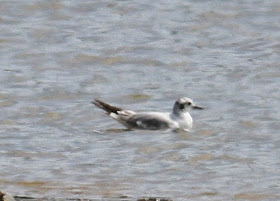This week I received an email from BTO HQ asking if I was able to go and ring a brood of Common Swifts Apus apus near me in Lee on Solent. Fortunately I knew the lucky home owner and so made contact, and arranged a suitable time to visit. Mark had been trying to get swifts to use his boxes for around 10 years, but with little success. Initially he had put his boxes on the southern side of his house, but four or five years ago he put them on the north side. It was this change of elevation, combined with playing the call of common swift that has proved to be the irresistible combination for swifts, or was it?
 |
| Common Swift on nest with two eggs (Mark Wagstaff) |
Mark originally bought expensive boxes made by the German company Schwegler, but when he changed elevations he erected cheaper wooden boxes made by John Stimpson as well, and is was one of these that got used first. These simple wooden boxes come with a nest cup, and are fitted to the wall by two screws. Mark made one adaptation, to one of his boxes, he fitted a camera.
 |
| Two adult Swifts on nest cup (Mark Wagstaff) |
Whilst Mark was aware that Swifts occasionally roosted in his boxes, it was the presence of the camera that confirmed that they were breeding, and that the pair had two chicks.
 |
| One adult and two juvenile Swifts (Mark Wagstaff) |
Swift boxes as well as being attractive to Swifts are also attractive to House Sparrows and Starlings. Since these species are resident, if given the opportunity they would quickly take up residence before the swifts arrive each year, and prevent them from doing so. To counter this Mark puts a bit of adhesive tape over the hole; this is removed once he hears a report of the first common swift of the year in the UK. By this time the resident House Sparrows and Starlings are already nesting and so are not interested in the boxes.
 |
| Line of Swift Boxes under the Eaves of his House |
We agreed that a suitable day for me to visit was Friday (27th June). The boxes were situated directly under the eaves on the northern elevation, and one on the front of the house (facing east). There were four wooden boxes, and two Schwegler woodcrete boxes. The swifts were nesting in the end, westernmost wooden box. As we stood talking prior to me climbing the ladder one of the adults exited the box and flew off high.
 |
| Two Common Swift chicks (Pulli) |
The chicks were huddled at the back of the box, and were a good healthy weight, one being 48.8 grams and the other 46.1. Their wings were over half their adult length, with the heavier birds being 94mm and the lighter one 88mm. At this age it was possible to see the distinctive white fringing to their feathers, and the white forehead and throat. Swift chicks will fledge at between 37 - 56 days, so these birds have a few weeks in the nest yet.
 |
| Adult Common Swift |
Whilst I was up the ladder an adult swift exited the easternmost box, one of the Schweglers. Mark was aware that occasion birds had been roosting in some of the other boxes, but he was unaware of this one being used. I quickly climbed up the ladder to have a look and there was an adult bird sat in it, and a nest with two eggs. I have ringed a quite a few swifts in my time and have not recorded nests with eggs this late before, which could suggest that the eggs maybe infertile. I will go back in a few weeks to check.
 |
| Adult Common Swift |
The adult bird had a maximum wing chord of 171mm and weighed only 47.6 grams, so lighter than one of the chicks. It is possible to age swifts to first and second summer by the shape and extent of wear on the wing and tail feathers. The wing feathers on this bird were broader and showed very little abrasion, although one of the feathers appeared quite worn, so I aged this bird as a four.


































